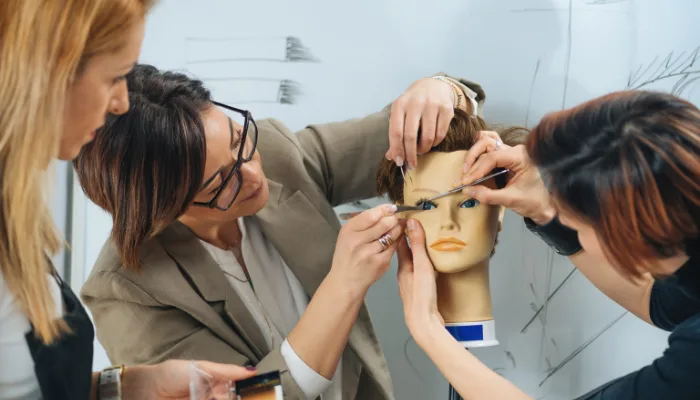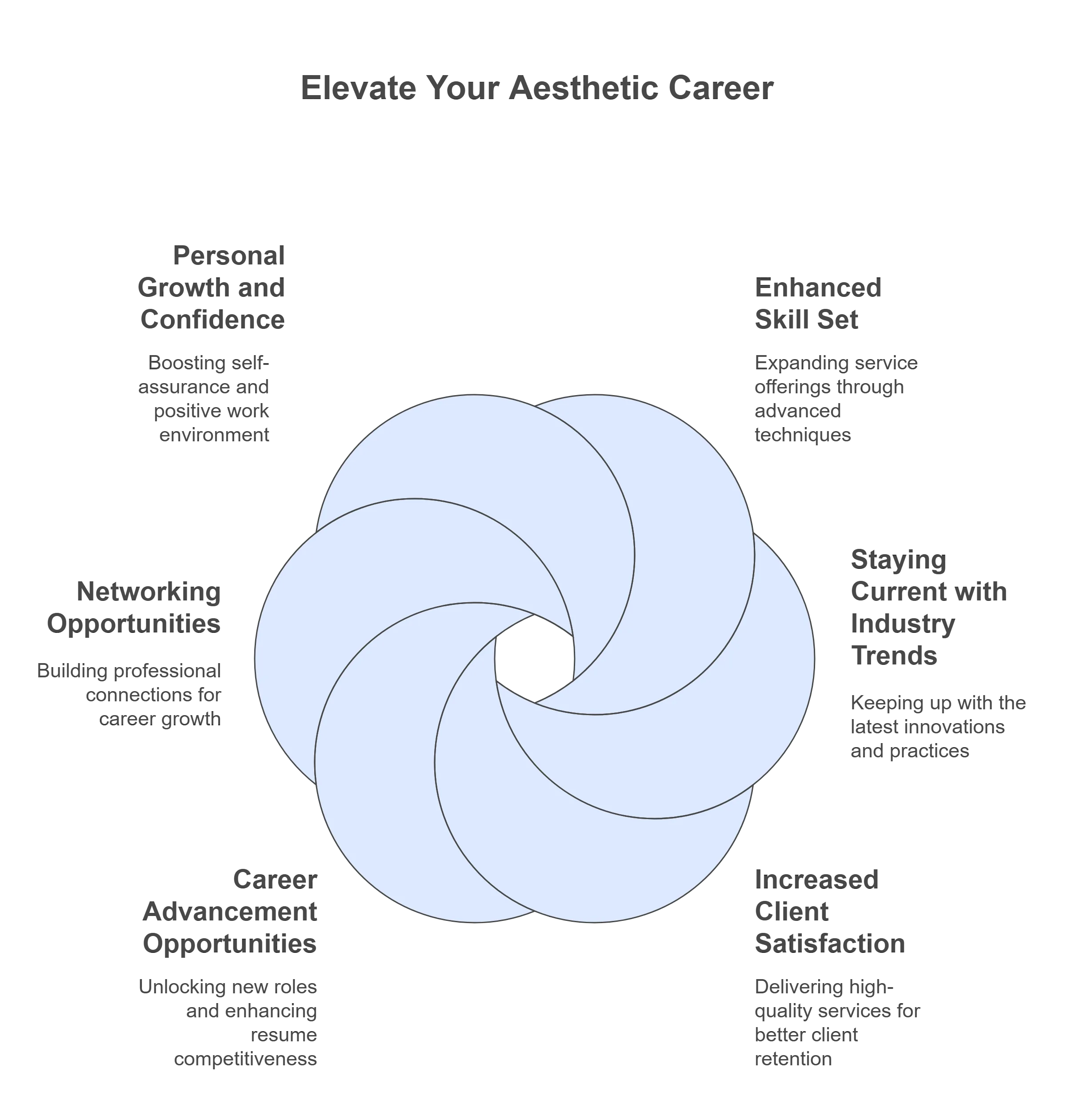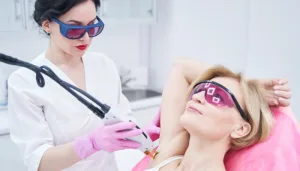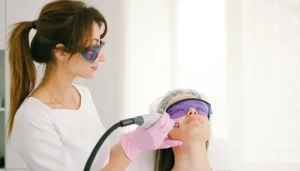
Advanced aesthetic courses are designed for those looking to deepen their knowledge and skills in non-surgical cosmetic procedures. These courses cover a range of topics, from injectables like Botox to advanced skin treatments.
With the beauty industry evolving rapidly, these courses are essential for professionals wanting to stay competitive and meet client demands. Advancing your training can open up new opportunities and enhance your practise.
Key Takeaways
- Advanced aesthetic courses boost your skills in non-surgical treatments.
- These courses cater to medical professionals and beauty practitioners alike.
- Hands-on training is a key component of these courses.
- Completing advanced courses can lead to better job prospects in the aesthetic field.
- Choosing accredited courses ensures you receive quality training.
Understanding Advanced Aesthetic Courses
Definition of Advanced Aesthetic Courses
So, what exactly are advanced aesthetic courses? Well, think of them as the next level up from your standard beauty or aesthetics training. They’re designed to equip practitioners with more in-depth knowledge and skills in specific areas of aesthetic treatments. It’s about going beyond the basics and really mastering techniques and understanding the science behind them.
These courses often focus on more complex procedures, new technologies, and advanced methods that aren’t typically covered in introductory training. Basically, it’s where you go to become a real expert.
Importance of Advanced Training
Why bother with advanced training? Because the aesthetics industry is constantly evolving. New products come out all the time, and techniques are always being refined.
Staying up-to-date is super important if you want to offer your clients the best possible service and stay ahead of the competition. Plus, advanced training can help you:
- Reduce the risk of complications by understanding advanced techniques.
- Increase your confidence in performing complex procedures.
- Expand your service menu to attract a wider range of clients.
- Potentially increase your earning potential.
Investing in advanced training isn’t just about learning new skills; it’s about investing in your future and ensuring you can provide safe, effective, and cutting-edge treatments to your clients.
Who Should Enrol in These Courses
Who are these courses actually for? Generally, advanced aesthetic courses are aimed at qualified and experienced practitioners who want to take their skills to the next level.
This might include:
- Doctors
- Nurses
- Dentists
- Aesthetic therapists with a solid foundation of experience
Basically, if you’ve already got some experience under your belt and you’re looking to specialise or expand your skillset, then an advanced course could be a great option. It’s not really for complete beginners, as they usually assume you have a good understanding of basic anatomy, physiology, and common aesthetic procedures.
Types of Advanced Aesthetic Courses
There’s a whole range of advanced courses out there, each focusing on different areas. It can feel a bit overwhelming trying to figure out which one is right for you, but let’s break down some of the most popular options.
Botox and Dermal Fillers Training
These are probably the most well-known advanced aesthetic courses. I mean, who hasn’t heard of Botox and fillers, right? But going beyond the basics is where things get really interesting. Advanced training here will teach you about more complex injection techniques, understanding facial anatomy in greater detail, and how to handle complications if they arise.
You’ll learn how to use these treatments for more than just wrinkle reduction – think facial contouring, lip augmentation, and even non-surgical rhinoplasty. It’s all about mastering the finer points.
Laser Aesthetic Courses
Laser treatment courses are a big deal in aesthetics, and there’s a lot to learn. These courses cover a wide range of laser and light-based therapies, from laser hair removal to skin resurfacing and tattoo removal. You’ll get to grips with different laser types, how they interact with the skin, and how to safely and effectively treat various skin conditions.
Plus, you’ll learn about things like client consultation, safety protocols, and how to manage expectations. It’s not just about zapping things with lasers; it’s about understanding the science behind it.
Advanced Skin Treatments
Beyond injectables and lasers, there’s a whole world of advanced skin treatments to explore. This could include things like chemical peels, micro-needling, and advanced skincare techniques.
These courses often focus on understanding skin biology in detail, identifying different skin types and conditions, and creating bespoke treatment plans for clients. You’ll learn how to use these treatments to address concerns like acne, pigmentation, and ageing, and how to combine them for maximum impact. It’s like becoming a skin detective, figuring out exactly what each client needs.
Choosing the right advanced aesthetic course really depends on your interests and career goals. Think about what areas of aesthetics you’re most passionate about, and what skills you want to develop. Do your research, talk to other practitioners, and find a course that’s going to give you the knowledge and confidence to excel. Good luck!
Benefits of Enrolling in Advanced Aesthetic Courses
Advanced aesthetic course is a big step, but the rewards can be pretty great. Let’s have a look at what you can get out of it.
Enhancing Professional Skills
Taking an advanced course isn’t just about getting a fancy certificate; it’s about properly levelling up your skills. You’ll learn new techniques and get a better understanding of the procedures you already do.
You’ll be able to handle more complex cases and get better results for your clients. Plus, you’ll feel more confident in your abilities, which is always a good thing.
Expanding Service Offerings
More skills mean more services you can offer. It’s simple maths, really. If you’re only doing basic treatments now, an advanced course can open the door to things like advanced dermal fillers, laser treatments, or even minor surgical procedures.
This not only attracts a wider range of clients but also lets you charge more for your services. It’s a win-win.
Increasing Client Satisfaction
Happy clients are the best advertisement you can get. When you can offer better results and a wider range of treatments, clients are more likely to be happy with what you do. This leads to repeat business and, more importantly, referrals.
People trust recommendations from friends and family, so keeping your clients happy is key to growing your business. Plus, it just feels good to know you’re doing a great job!
Investing in advanced aesthetic courses is an investment in your future. It’s about staying ahead of the curve, providing the best possible service, and building a thriving practise. It might seem like a big commitment, but the long-term benefits are well worth it.
Prerequisites for Advanced Aesthetic Courses
Before you jump in, it’s worth knowing what you’ll need to get accepted. It’s not always as simple as just signing up; there are usually a few boxes you need to tick.
Required Qualifications
First things first, let’s talk about qualifications. Most advanced aesthetic courses require you to have a background in medicine or aesthetics. This usually means being a registered nurse, doctor, dentist, or having a Level 4 qualification in aesthetics.
Why? Because these courses build on existing knowledge. If you’re completely new to the field, you might find yourself a bit lost.
- A medical degree (MBBS or equivalent)
- A nursing degree (RN)
- A dental degree (DDS or equivalent)
- Level 4 or above in Aesthetic Practise
Experience in Aesthetic Practise
Having the right qualifications is one thing, but practical experience is another. Many courses want to see that you’ve already spent some time working in the aesthetics industry. This could be anything from assisting with treatments to performing basic procedures yourself.
Why is experience important? Well, advanced courses often involve hands-on training with real clients. If you’ve never held a syringe before, you might struggle to keep up. Plus, having some experience means you’ll have a better understanding of what clients want and how to manage their expectations.
Continuing Professional Development
Finally, it’s worth thinking about your continuing professional development (CPD). The aesthetics industry is constantly evolving, with new techniques and technologies emerging all the time. To stay at the top of your game, it’s important to keep learning and updating your skills.
Many advanced courses will ask about your previous CPD activities. This could include attending workshops, conferences, or completing online training modules. Showing that you’re committed to ongoing learning will definitely boost your application. It shows you’re serious about aesthetics and dedicated to providing the best possible care for your clients.
Course Structure and Content
Theoretical Knowledge
First up, there’s the theory. Now, I know what you’re thinking: “Ugh, more lectures?” But trust me, this stuff is important. You’ll be going way beyond the basics, learning about advanced anatomy, different skin types, and the science behind the treatments.
It’s all about understanding what you’re doing and why. Think of it as building a solid foundation before you start constructing the house.
You’ll likely cover:
- Detailed facial anatomy and physiology
- Pharmacology of injectables (like Botox and fillers)
- Complication management and emergency protocols
- In-depth skin analysis and treatment planning
Hands-on Practical Training
Okay, now for the fun part: practical training! This is where you get to put all that theory into action. You’ll be working under the supervision of experienced instructors, practising on models, and getting comfortable with the techniques.
It can be a bit nerve-wracking at first, but that’s totally normal. The instructors are there to guide you and help you build your confidence. Expect to:
- Practise injection techniques on live models
- Learn advanced injection techniques (e.g., cannula use)
- Gain experience with different types of equipment (e.g., lasers, energy-based devices)
- Develop your consultation and patient assessment skills
Assessment and Certification
Finally, there’s the assessment. This is how the course providers make sure you’ve actually learned something! It might involve written exams, practical assessments, or case studies.
Don’t stress too much about it; if you’ve been paying attention and putting in the effort, you’ll be fine. And once you pass, you’ll get a shiny new certificate to prove it! This usually includes:
- Written examinations to test theoretical knowledge
- Practical assessments to evaluate skills
- Case study presentations
- A final certification upon successful completion
Advanced aesthetic courses aren’t just about learning new techniques; they’re about developing a deeper understanding of the field and becoming a more confident and competent practitioner. It’s an investment in your future, and it can open up a whole new world of opportunities.
Career Opportunities After Advanced Aesthetic Courses
Expanding Your Aesthetic Practise
What’s next? Well, one of the most obvious routes is to expand your current aesthetic practise. Think about it: you’ve now got a whole new skillset to offer your clients.
This could mean introducing new treatments, catering to a wider range of needs, and ultimately, attracting more business. It’s like upgrading from a bicycle to a motorbike – you can go further, faster, and offer a more exciting ride!
Opportunities in Medical Aesthetics
Advanced aesthetic courses can also open doors to opportunities within medical aesthetics. This might involve working in a clinic alongside doctors and nurses, providing treatments under their supervision.
It’s a chance to be part of a larger team, gain experience in a medical setting, and potentially specialise in a particular area of aesthetics. Plus, the pay can be pretty good too!
Freelancing and Consultancy Roles
Advanced aesthetic training can pave the way for freelancing and consultancy roles. Imagine setting your own hours, choosing your clients, and working on projects that genuinely excite you.
As a freelance aesthetician, you could offer your services to various clinics, spas, or even private clients. Alternatively, you could become a consultant, advising businesses on the latest aesthetic trends and treatments.
Taking advanced aesthetic courses is a smart move for anyone serious about a career in this field. It’s not just about learning new skills; it’s about opening doors to a world of exciting opportunities and taking control of your professional destiny.
Choosing the Right Advanced Aesthetic Course
With so many options out there, how do you make sure you’re picking the right one? It can feel a bit overwhelming, but don’t worry, I’m here to help you break it down. It’s all about doing your homework and figuring out what matters most to you and your career goals.
Accreditation and Recognition
This is probably the most important thing to look for. You want to make sure the course you’re considering is actually recognised by reputable bodies. Accreditation means the course has been vetted and meets certain standards, which is important for your credibility and for getting insurance later on.
Look for courses that are QUALIFI certified. If a course isn’t accredited, it might not be worth the paper it’s printed on, so do your research!
Course Duration and Format
Think about how the course fits into your life. Are you able to commit to a longer, more intensive course, or do you need something shorter and more flexible? Some courses are spread out over several weeks or months, while others are condensed into a few days.
Also, consider the format – is it online, in-person, or a mix of both? Online courses can be great for flexibility, but in-person training is often better for hands-on experience. Here’s a quick table to help you think about it:
| Feature | Intensive Course | Flexible Course |
|---|---|---|
| Duration | Short (days) | Longer (weeks) |
| Time Commitment | High | Lower |
| Learning Style | Immersive | Self-paced |
| Best For | Quick skill boost | Busy professionals |
Instructor Qualifications
Who’s teaching the course? Are they experienced practitioners with a good reputation? Do they have the right qualifications and a proven track record? It’s worth checking out their background and reading reviews from previous students.
A good instructor can make all the difference in your learning experience. You want someone who’s not only knowledgeable but also able to explain things clearly and provide helpful feedback.
Choosing the right advanced aesthetic course is a big decision, but by considering these factors, you can find a course that will help you achieve your career goals and provide you with the skills and knowledge you need to succeed. Don’t rush the process, do your research, and choose wisely!
Conclusion
Advanced aesthetic courses are a fantastic way to boost your skills and knowledge in the ever-evolving field of aesthetics. These courses can help you stay ahead of the curve. They cover a range of techniques and procedures that are in high demand, ensuring you can meet your clients’ needs effectively.
Plus, with hands-on training and ongoing support, you’ll feel confident in applying what you learn. So, if you’re looking to enhance your career in aesthetics, enroll now in one of these courses. It could be the step that transforms your practise and opens up new opportunities.
Frequently Asked Questions
What are advanced aesthetic courses?
Advanced aesthetic courses are special training programmes for professionals who want to learn advanced techniques in beauty treatments, like Botox or fillers.
Why should I take an advanced aesthetic course?
Taking an advanced aesthetic course can help you improve your skills, offer more services, and increase your chances of getting more clients.
Who can join these courses?
These courses are mainly for medical professionals, like doctors and nurses, who want to start or improve their careers in beauty treatments.
What do I need to join an advanced aesthetic course?
You usually need to have some basic qualifications in beauty or healthcare, and some experience in the field is helpful.
What job opportunities are there after completing these courses?
After completing an advanced aesthetic course, you can work in clinics, start your own business, or even offer freelance services.
What will I learn in these courses?
You will learn both theory and practical skills, including how to perform various aesthetic procedures safely and effectively.







